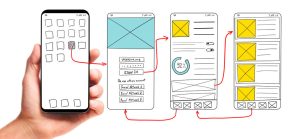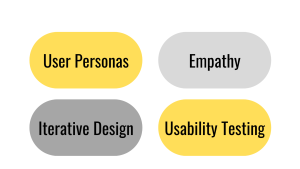content
UI/UX design
October 31, 2023
6 min read
Introduction
In today’s digital age, user-centered design has become an integral part of creating successful and enjoyable user experiences. Whether you’re designing a website, a mobile app, or any digital product, the principles of user-centered design play a pivotal role in ensuring that your users not only navigate your interface with ease but also enjoy the process. This article explores the core principles of user-centered design, including empathy, user personas, and usability testing, and how they contribute to crafting intuitive and enjoyable experiences.
What is user-centric design
User-Centric Design, often referred to as User-Centered Design (UCD), is a design approach that places the user’s needs, preferences, and experiences at the forefront of the design process. It encompasses User Experience (UX) and User Interface (UI) design to ensure that digital products and services are not only visually appealing but also highly functional and user-friendly.

User Interface (UI) Design involves the aesthetics and layout of a digital product, focusing on the elements that users interact with directly. It includes everything from the visual design of buttons and menus to the overall look and feel of the user interface. The goal of UI design is to create an attractive and user-friendly interface that facilitates smooth interactions between users and the product.
On the other hand, User Experience (UX) Design extends beyond the visual aspects and delves into the overall experience a user has while interacting with a digital product. This encompasses the user’s journey from the moment they first encounter the product to their ongoing interactions. UX design aims to make this journey intuitive, enjoyable, and efficient.
User-Centric Design principles
User-Centric Design emphasizes the following key principles.

Empathy: The Foundation of User-Centered Design
Empathy is at the heart of user-centered design. To create products that truly resonate with your users, you must step into their shoes and understand their needs, desires, and pain points. Empathy is about developing a deep understanding of the people who will use your product. This understanding should go beyond demographics and delve into the emotions and motivations that drive user behavior.
To cultivate empathy, designers engage in activities such as user interviews, surveys, and observing user behavior. These activities allow them to connect with their target audience and gain insights into what the users expect from the product. By embracing empathy, designers can ensure that their work resonates with the intended audience, leading to a more enjoyable user experience.
User Personas: Giving Users a Face and a Story
User personas are fictional representations of your target users, based on real data and research. They give a face and a story to the abstract idea of your user base. Creating user personas helps designers understand their users on a personal level and cater to their specific needs and preferences.
To create user personas, demographic information, preferences, goals and pain points are collected. These personas help designers make informed decisions during the design process. For example, if you’re creating a travel app, you might have characters like “Adventurous Amy” and “Frugal Brian.” Understanding these personas allows you to tailor the design to their unique needs, ensuring that the application is intuitive and enjoyable for both.
Usability Testing: Ensuring Practicality and Enjoyment
Usability testing is an essential step in the user-centered design process. It involves real users interacting with a prototype or the final product, providing feedback that helps designers identify usability issues and make necessary improvements. Usability testing ensures that your design is not only user-friendly but also enjoyable to use.
Usability testing can be done through moderated sessions, where a researcher guides users through tasks, or unmoderated tests where users navigate the product independently. By watching users interact with your product, you can identify pain points, confusion, or any other obstacles that hinder a smooth user experience. This feedback is invaluable in refining your design to make it more intuitive and enjoyable.
Iterative Design: Continuously Improving the User Experience
User-centered design is an iterative process. It involves creating, testing, and refining your product repeatedly. Through this iterative approach, you can incrementally improve the user experience and address any issues that arise.
Each iteration brings you closer to a design that aligns better with user needs and expectations. User feedback, whether from usability testing or user research, becomes the compass guiding your design decisions. By constantly refining your design, you can ensure that the user experience evolves into something not only intuitive but genuinely enjoyable.
Conclusion
User-centered design is an art that requires a deep understanding of your users, a commitment to creating user personas, and a dedication to usability testing and iterative refinement.
Empathy connects you with your users on an emotional level, ensuring that your design resonates with their needs and desires.
The art of user-centered design isn’t just about making your product work; it’s about making it work in a way that brings delight to your users. When we create designs that users find intuitive and enjoyable, we not only meet their needs but also build trust and loyalty, making your product a success in the digital landscape.
If you have any questions or an idea for a project, contact us via sales@instandart.com or fill out the form on the main page of the site to discuss. We are always ready to help!
